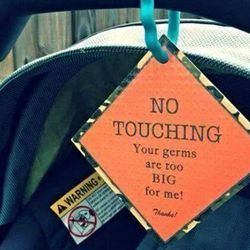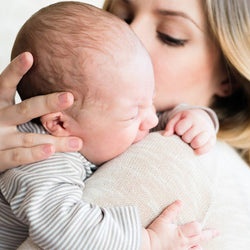How to Teach Consent Across the Ages
Opportunities from babyhood and beyond to demonstrate that your child’s voice matters.

by Jess Wartinger
Mar 15, 2018
With news story after story shedding light on childhood sexual abuse, you may start to wonder how best to protect your child. When is the perfect time to teach about body autonomy and consent? Furthermore, what is the best approach to this, without sharing graphic details or scaring kids?
While childhood sexual abuse is an extremely heavy topic, teaching kids strength in body and mind can occur everyday (and has long-lasting benefits).
These are the main goals of teaching consent:
1. My child will know what is okay.
2. My child will know what is not okay.
3. My child will know how to say “no” or “stop” even in high-pressure situations.
4. My child will feel comfortable communicating with me, about any topic, without shame.
While these goals seem to rely on a child being old enough to hold conversations, there are many opportunities from babyhood and beyond to demonstrate that your child’s voice matters.
Teaching Consent to Babies
The topic of consent throughout infancy and the babyhood isn’t often acknowledged, yet we’ve all seen babies who don’t consent to circumstances. When handed to an unfamiliar person, a baby might get scared or uncomfortable. Crying, arching, and fussing are all ways babies show their discontent.
All babies have periods when they’re more attached to mom and dad. Instead of trying to distract an upset baby by moving him away from parents, unfamiliar faces could slowly gain baby’s trust by playing with him while he sits on mom’s lap. Acknowledging that baby hasn’t yet consented to snuggling an unfamiliar adult reinforces the idea that it’s okay not to share your space when you feel a gut-level uncomfortableness.
While it’s not realistic to expect parents to always be able to hold baby, it is important to slowly build a bond between safe people and your infant. Spending time as groups and allowing baby to naturally form an attachment to others gives him the opportunity to become comfortable at his own pace.
Older generations may believe moving a baby away from mom and dad will help to distract her long enough to forget her discomfort. Currently though, acknowledging this uncomfortable feeling will be beneficial as babies grow into toddlers and learn more about body autonomy.
Teaching Consent to Toddlers
A typical day parenting a toddler involves many instances of telling a child what to do with her body. Sitting in specific places, giving makeup hugs after squabbles, even when (and how) to get dressed are typically dictated to toddlers. While none of these instances are bad, they don’t serve to help toddlers develop a sense of their body as their own.
Here are specific ways throughout the day to begin teaching toddlers consent:
➔ Physical affection is never a requirement. Bedtime hugs, hugs of apology, or kisses for grandparents aren’t required to avoid hurting others’ feelings. Look for alternatives to sharing personal space such as waving, fist-bumps, or high-fives.
➔ Teach toddlers about their bodies, using correct vocabulary when referring to anatomy.
➔ When toddlers bring up conversations about male/female anatomy don’t be shocked and be sure to answer questions truthfully, using correct vocabulary at age-appropriate levels.
➔ Practice saying “no.” Give your toddlers opportunities for choice and practice saying a forceful “no.”
Consider continuing to build deep friendships with select others. Spend time together, monitor others interactions with your child, and allow them to begin forming bonds. It takes a village to raise a child and toddlerhood is a perfect time to solidify other “safe” people into your child’s life.
Teaching Consent to Preschoolers
Preschool children are at a great age to solidify the principles of body autonomy and consent. While a traditional conversation surrounding consent includes talk of sex, consent is, at its basic level, giving permission for something to happen. Preschoolers are old enough to have a say about what happens to their bodies.
Here are ways to teach your preschooler consent:
➔ Teach preschoolers what different emotions feel like (such as butterflies when nervous). Specifically learn the concept of “uncomfortable” including how this feels internally.
➔ Instill the idea that consent is always a requirement before physical contact, even for safe people such as mom, dad or trusted friends.
➔ Continue the practice of saying “no” forcefully, especially in high-pressure situations where kids might freeze or feel pressured to comply with an uncomfortable physical request.
➔ Teach preschoolers to bathe independently and practice giving them privacy to wash without assistance.
For parents of the past, teaching consent almost feels like giving children liberty to disobey. Obedience isn’t in question here, as consent is on the table only during situations where children are asked to comply in a physical manner.
Are you interested to see how it looks to teach preschoolers consent? Check out this video for some simple ways to acknowledge kids feelings and teach consent in everyday situations:
Article Continues Below Advertisement
Looking for even more information on this subject? Read "Teaching Kids More Than Just Consent".
Jess Wartinger
Jess Wartinger resides in rural New York with her husband and five children. Formerly an early elementary teacher, Jess currently spends her time loving her kids and holding down the fort at home.










